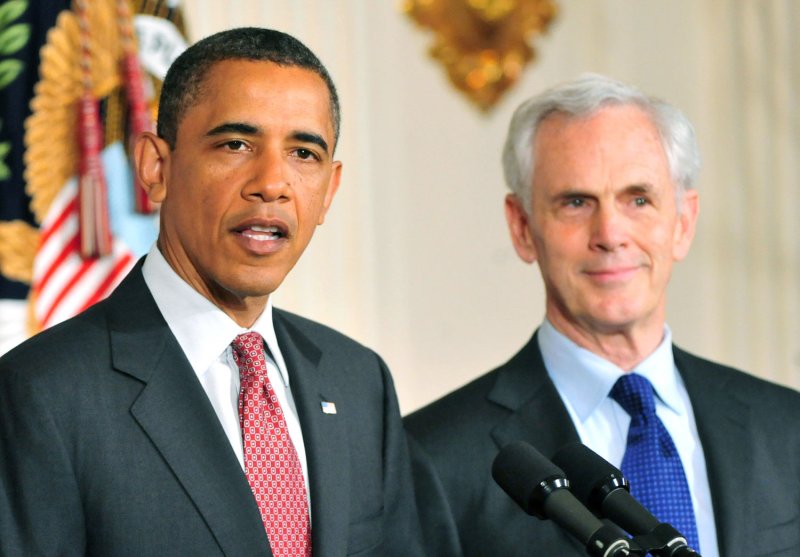President Barack Obama introduces Commerce Secretary nominee John Bryson in the State Dining Room at the White House in Washington on May 31, 2011. Bryson is replacing current Commerce Secretary Gary Locke. UPI/Kevin Dietsch |
License Photo
COLLEGE PARK, Md., June 9 (UPI) -- The U.S. Commerce Department reported Thursday the April deficit on international trade in goods and services was $43.7 billion, up from $27.1 billion in when the economic recovery began.
The trade deficit, along with the credit and housing bubbles, were the principal causes of the Great Recession. A rising trade deficit again threatens to sink the recovery and push unemployment to more than 10 percent.
Most fundamentally, U.S. economic growth and jobs creation has slowed, because the demand for U.S. made goods and services is expanding too slowly. Supplying what Americans and global consumers buy isn't the issue but rather U.S. and export customers don't want enough of what Americans could make.
At 3.5 percent of gross domestic product, the trade deficit subtracts more from the demand for U.S.-made goods and services than U.S. President Barack Obama's stimulus package added. The Obama stimulus was temporary and is dissipating, whereas the trade deficit is permanent and swollen again.
The high cost of imported oil and gasoline and subsidized manufactures from China account for nearly the entire deficit. During the recovery, the cost of imported oil and Chinese imports have risen with consumer spending and these threaten to sink the recovery by year end.
Money spent on Middle East oil and Chinese coffee makers cannot be spent on U.S.-made goods and services, unless offset by exports.
When imports substantially exceed exports, Americans must consume much more than the incomes they earn producing goods and services or the demand for what they make is inadequate to clear the shelves, inventories pile up, layoffs result and the economy goes into recession.
To keep Chinese products artificially inexpensive on U.S. store shelves and discourage U.S. exports into the Middle Kingdom, China undervalues the yuan by 40 percent.
Beijing accomplishes this by printing yuan and selling those for U.S. dollars to augment the private supply of yuan and private demand for dollars. Annually, those purchases come to about $450 billion, or about a 35 percent subsidy on China's exports of goods and services.
Similarly the failure to develop U.S. oil and gas resources -- and speed the deployment of natural gas use and more fuel efficient vehicles -- sends abroad dollars that don't return to purchase U.S. exports. Greater domestic production and conservation might not much lower the price of gasoline or heating oil but it would keep more of the dollars spent on energy in the United States, creating jobs.
Cutting the trade deficit in half over three years would increase U.S. GDP by about $500 billion and create up to 5 million additional jobs. This would increase growth to 3.6 percent from the expected 2.5 percent and lower the unemployment rate by 3 percentage points.
Absent some correction in the trade deficit, growth at 2.5 percent may prove too slow to be sustainable. Many companies will find they can boost productivity and slash payrolls to keep up with such slow growth and undermine consumer confidence and send the economy into a negative spiral and recession.
Longer term, the combination of expensive oil imports and China's currency policies reduce U.S. growth by one percentage point a year. The U.S. economy would likely be $1.5 trillion larger today but for the trade deficits on oil and with Asia over the last 10 years.
China has indicated it won't significantly revalue its currency. Gradual revaluation of the yuan helps little because modernization and accompanying productivity improvements raise the intrinsic value of the currency at about the same pace. This is evidenced by the continuing pace of Beijing's purchases of dollars and other currency to keep the yuan at its target exchange rate.
China views its exchange rate policy as a tool of domestic development strategy but its policy has broad, aggressive and negative international consequences -- it is choking growth and imposing high unemployment on the United States and other Western countries.
Diplomacy has failed and Obama should impose a tax on dollar yuan conversions in an amount equal to the amount of China currency market intervention divided by its exports -- about 35 percent. For imports, at least, that would offset China's subsidies that harm U.S. businesses and workers.
After diplomacy has failed for both Presidents George W. Bush and Obama, failure to act amounts to no more than appeasement and wholesale neglect of the administration's obligations to create a level playing field for U.S. workers.
--
(Peter Morici is a professor at the Smith School of Business, University of Maryland School, and former chief economist at the U.S. International Trade Commission.)
--
(United Press International's "Outside View" commentaries are written by outside contributors who specialize in a variety of important issues. The views expressed do not necessarily reflect those of United Press International. In the interests of creating an open forum, original submissions are invited.)















